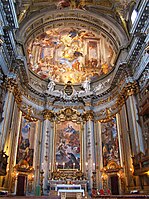
Back Barok argitektuur Afrikaans عمارة باروكية Arabic Barokko memarlığı Azerbaijani Барокова архитектура Bulgarian Arquitectura barroca Catalan Architettura barocca Corsican Barokní architektura Czech Architektur des Barock German Μπαρόκ αρχιτεκτονική Greek Arquitectura del Barroco Spanish
Clockwise from top left: Church of Saint Ignatius of Loyola in Italy, Church of Santa Prisca de Taxco in Mexico, Smolny Cathedral in Russia, St-Gervais-et-St-Protais in France | |
| Years active | Late 16th–18th centuries |
|---|---|
Baroque architecture is a highly decorative and theatrical style which appeared in Italy in the late 16th century and gradually spread across Europe. It was originally introduced by the Catholic Church, particularly by the Jesuits, as a means to combat the Reformation and the Protestant church with a new architecture that inspired surprise and awe.[1] It reached its peak in the High Baroque (1625–1675), when it was used in churches and palaces in Italy, Spain, Portugal, France, Bavaria and Austria. In the Late Baroque period (1675–1750), it reached as far as Russia, the Ottoman Empire and the Spanish and Portuguese colonies in Latin America. In about 1730, an even more elaborately decorative variant called Rococo appeared and flourished in Central Europe.[2][3]
Baroque architects took the basic elements of Renaissance architecture, including domes and colonnades, and made them higher, grander, more decorated, and more dramatic. The interior effects were often achieved with the use of quadratura (i.e. trompe-l'œil painting combined with sculpture): the eye is drawn upward, giving the illusion that one is looking into the heavens. Clusters of sculpted angels and painted figures crowd the ceiling. Light was also used for dramatic effect; it streamed down from cupolas, and was reflected from an abundance of gilding. Twisted columns were also often used, to give an illusion of upwards motion, and cartouches and other decorative elements occupied every available space. In Baroque palaces, grand stairways became a central element.[4]
The Early Baroque (1584–1625) was largely dominated by the work of Roman architects, notably the Church of the Gesù by Giacomo della Porta (consecrated 1584) façade and colonnade of St. Peter's Basilica by Carlo Maderno (completed 1612) and the lavish Barberini Palace interiors by Pietro da Cortona (1633–1639), and Santa Susanna (1603), by Carlo Maderno. In France, the Luxembourg Palace (1615–45) built by Salomon de Brosse for Marie de' Medici was an early example of the style.[5]
The High Baroque (1625–1675) produced major works in Rome by Pietro da Cortona, including the (Church of Santi Luca e Martina) (1635–50); by Francesco Borromini (San Carlo alle Quattro Fontane (1634–1646)); and by Gian Lorenzo Bernini (The colonnade of St. Peter's Square) (1656–57). In Venice, High Baroque works included Santa Maria della Salute by Baldassare Longhena. Examples in France included the Pavillon de l’Horloge of the Louvre Palace by Jacques Lemercier (1624–1645), the Chapel of the Sorbonne by Jacques Lemercier (1626–35) and the Château de Maisons by François Mansart (1630–1651).
The Late Baroque (1675–1750) saw the style spread to all parts of Europe, and to the colonies of Spain and Portugal in the New World. National styles became more varied and distinct. The Late Baroque in France, under Louis XIV, was more ordered and classical; examples included the Hall of Mirrors of the Palace of Versailles and the dome of Les Invalides. An especially ornate variant, appeared in the early 18th century; it was first called Rocaille in France; then Rococo in Spain and Central Europe. The sculpted and painted decoration covered every space on the walls and ceiling. Its most celebrated architect was Balthasar Neumann, noted for the Basilica of the Fourteen Holy Helpers and the Würzburg Residence (1749–51).[6]
- ^ Gauvin Alexander Bailey, Between Renaissance and Baroque: Jesuit Art in Rome, 1565–1610 (Toronto: University of Toronto Press, 2003).
- ^ Oudin, Dictionnaire des Architectes (1994), pp. 43–44
- ^ Ducher (1988), Flammarion, pp. 102–104
- ^ Ducher (1988), Flammarion, p. 102
- ^ Toman (Rolf, L'Art Baroque – Architecture – Sculpture- Peinture (2015) pp. 12–70
- ^ Toman (2015), pp. 190–194



